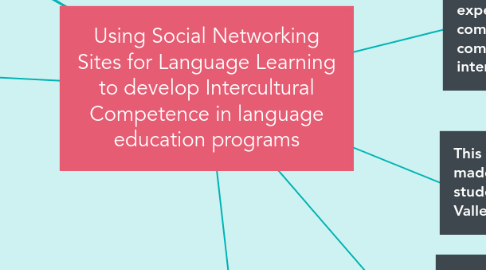Using Social Networking Sites for Language Learning to develop Intercultural Competence in language education programs
by Ingrid Alexandra Troncoso Rodriguez


1. Data was collected through screen recordings, students' logs, surveys and focus groups.
1.1. Data was analysed by a theoretical or deductive thematic analysis and content analysis. Statistics was used to get a general picture of the students' ability to operate intercultural skills.
1.2. Triangulation was ensured by collecting information from various kinds of data gathered and via the review and analysis of the data by both researchers.
2. This research article examines the ways a social networking site for language learning "livemocha" enhances or hinders Intercultural communicative competence
2.1. Livemocha, as other SNSLLs, is a multimodal online platform that provides access to pedagogical materials, activities and social interactions in multiple languages
3. This research contributes to the studies of SNSLLs by filling the gap in the literature about the examination of the role of intercultural dimension in such digital environments and it sheds light on the potentialities of integrating SNSLLs in language teaching education programs
4. Conclusions: this report provides partial insight into the development of ICC of a group of students during a specific period of time. This was a syncronic indicator of IC development.
4.1. 1. integration of SNSLLs in language classes has the potential to promote intercultural behaviors and attitudes;
4.2. 2. Most of ICC components appeared in data set;
4.3. 3. Content, language exercises and interactions exposed students to unfamiliar situations which prompted the expansion of their cultural semiotic repertoires;
4.4. 4. students decentered and open themselves to examine cultural practices;
4.5. 5. interactions provided the contexts to intracultural and intercultural reflection, discovery and transformation;
4.6. 6. absence of critical cultural awareness is due to limitations in the nature of interactions, technical affordances of Livemocha and the need for pedagogical adaptations of contents and tasks;
4.7. 7. data showed that development of ICC is an ongoing process
5. Nowadays learners are expected to develop communicative competence and intercultural competence
5.1. "Intercultural competence describes a capability that enables people from different cultural backgrounds to interact, bringing into their act of sign-making their societal, cultural, and individual knowledge about the world to make possible and effective negotiation of meanings." Alvarez & Fernandez, 2019, pp 25.
5.1.1. Byram's model to develop IC:
5.1.1.1. 1. Attitudes:
5.1.1.2. 2. Knowledge
5.1.1.3. 3.1 Skills for interpreting and relating
5.1.1.4. 3.2 Skills of discovery and interaction
5.1.1.5. 4. Critical cultural awareness/ political education
